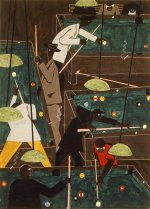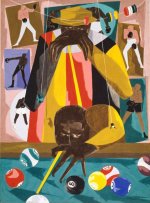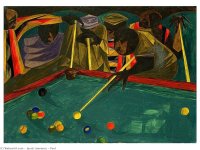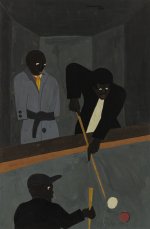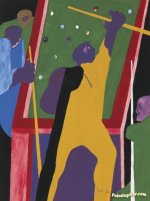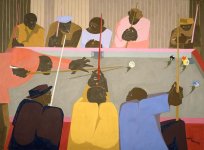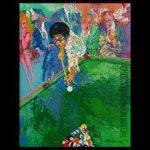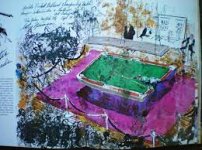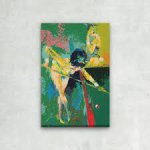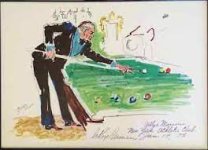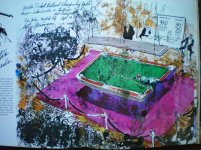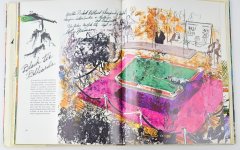Lawrence is renowned for his visual interpretations of Black life and history, which he often explored in series. This painting evokes a scene along Lenox Avenue, a central street in Harlem known at the time for its many pool parlors. The composition reveals a dimly lit room filled with dark-green pool tables punctuated with brightly colored billiard balls. Men focus intently on their competitive and communal recreation, while a few spectators look on. Zigzags of cigarette smoke and pool cues further animate the image.
Pool Parlor is the first work by Lawrence that entered The Met collection. The Museum purchased the painting as a prizewinner in its "Artists for Victory" competition in 1942, a celebratory exhibition of contemporary American art during World War II. This acquisition was a rare recognition of the talent of an artist of color by the Museum at the time. Lawrence’s artistic star had risen the previous year, when the painter, then only twenty-three years old, debuted his ambitious sixty-panel Migration Series (1940–41; Museum of Modern Art, New York and Phillips Collection, Washington, D.C.), which dramatized the mass internal migrations of African Americans moving out of the segregated and rural South to Northern and Midwestern cities to find jobs, better housing, and freedom from oppression.
from: https://www.metmuseum.org/art/collection/search/488043
Pool Parlor is the first work by Lawrence that entered The Met collection. The Museum purchased the painting as a prizewinner in its "Artists for Victory" competition in 1942, a celebratory exhibition of contemporary American art during World War II. This acquisition was a rare recognition of the talent of an artist of color by the Museum at the time. Lawrence’s artistic star had risen the previous year, when the painter, then only twenty-three years old, debuted his ambitious sixty-panel Migration Series (1940–41; Museum of Modern Art, New York and Phillips Collection, Washington, D.C.), which dramatized the mass internal migrations of African Americans moving out of the segregated and rural South to Northern and Midwestern cities to find jobs, better housing, and freedom from oppression.
from: https://www.metmuseum.org/art/collection/search/488043
